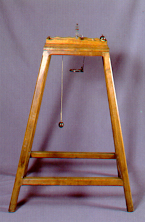
37.5 x 46.5 x 29
Wood and iron
INDEX 1788 : B.IV.e.82
Nova Machina constans ex Mensula lignea, in cujus medio fixa est capsula ferrea foramine pertusa, quod clauditur a lamina ferrea mobili subtus posita. Haec lamina duos habet funiculus extremis capitibus adnexos, qui dextrorsum, et sinistrorsum super trochleas excurrunt. Funiculo, qui ad sinistrum latus movetur, juguntur funiculi certae longitudinis, alius post alium, quorum unicuique appensa est pila ferrea diametro linear. 17. quae pila filo suspenditur, atque dum sibi libere committitur lamellam mobilem decidendo secum ducit, et ita clauditur foramen capsulae ferrea. Dum haec pila suspensa remanet, ducta ad dextrum latus lamina, foramen capsulae aperitur, quod ut capsula Hydrargyro impleatur, claudere oportet. Ad hoc comparatae sunt pilae ferreae minores (6 sunt numero) pellibus imbutae, quarum una adnectitur foramini, et arcte filo tenetur. Filum hoc, et filum alterius pilae maioris ita ducuntur, ut duas laminas ferreas, quae capsulae imminent, simul pertranicant; ac postea cochleis hunc in finem paratis firmentur. Sub capsulae foramine patella ferrea residet, quae poculum debet sustinere. Capsula hydrargyro interea repleta, eodem puncto temporis scinduntur forcipe fila; decidunt ambae pilae, ac perforamen exit hydrargyrum, quod apoculo colligitur, donec pila mayor spatium percurrat a suo funiculo determinatum. Hoc jam percurso spatio vi sua pila decidua laminam mobilem secum vehit, ac foramen clauditur. Tantundem ergo hydrargyri exire potuit, quantum poterat eo temporis intervallo, quo altera pila suum spatium confecit. Hujus itaque pondus hydrargyri instar temporis sumi potest: atque ita hujusmodi Machina [quae in experimento insistit basi ligneae quatuor pedibus intructae] optime ostenditur spatia a gravibus corporibus motu aequabiliter accelerato percursa esse in ratione duplicata temporum. Eadem inventa fuit a Praeceptore meo Viro laudatissimo Marchione Joanne Poleno.
A new machine composed of a small wooden table in the middle of which is a little iron box with a hole that can be closed by a movable iron bolt underneath. This bolt has two cords attached to its ends , from the right side and the left side , that pass over pulleys. Cords of a specific length are attached, one after the other, to the left-hand cord. An iron ball with a diameter of 17 lines was suspended from each one. This ball is suspended by a cord, and when the ball is allowed to fall, this cord pulls the movable bolt, thus closing the opening of the iron box. While this ball remains suspended, the bolt is pulled to the right, opening the hole in the box through which it is filled with mercury. Six smaller iron balls covered in leather are attached to this; one of which is connected to the hole and is held with a cord. This cord and the cord of the bigger ball are extended in such a way that they are crossed at the same time by two iron blades that are suspended from the box and then fixed by screws prepared for this task. There is an iron plate under the hole in the box where there should be a glass. The box being full of mercury, the threads are cut both at the same time, the two balls fall and the mercury exits from the hole, collecting in the glass until the big ball has covered the space dictated by its cord. After it has covered this space the ball falls by means of its own force and pulls the movable bolt with it, opening the hole. Thus, as much mercury can escape as is possible during the time taken by the other ball to make its fall through space. Thus the weight of this mercury can be taken as being equivalent to the time taken by the fall; and thus with a machine of this type (which is supported on a four-legged wooden base) it is clearly shown that the distances covered by bodies with an equally accelerated movement are proportional to the square of the journey times. This apparatus was invented by my tutor, the highly respected Marquis Giovanni Poleni.
The falling of bodies was without doubt one of the first physical phenomena that man attempted to understand. This research gave rise to the development of a variety of instruments designed to establish a relationship between the distance traversed by bodies in free-fall, and the corresponding time of motion. Galileu represents an illustrious example of this continual research aimed at the understanding of natural phenomena.
According to dalla Bella, in his work entitled Physices Elementa, the machine on display here was invented by his master Giovanni Poleni, who taught successively astronomy, physics and mathematics at the University of Venice.
Part of the set of pieces constituting this machine is a little table. A small iron box with a little hole in the bottom is placed in the middle of the tabletop. The box is filled with mercury which, when the hole is opened, drains through and collects inside a glass fixed on an iron support which in turn is fastened to the underside of the table. In order to open or close the hole, a bolt which is fastened underneath the box, is made to move.
The basis of the process consisted of allowing a sphere to fall freely for a certain time in such a way that the sphere, on commencing to fall, unplugged the hole through which mercury would then run into a glass, closing the hole on terminating its fall. The difficulty of measuring the time of the fall directly was avoided by taking the weight of the mercury displaced during this time as the value proportional to it. If the sphere covered, in free fall, a distance four times that of the first, its trajectory would take twice the time, this value being known since twice the quantity of mercury would have been displaced.
In order to observe the fall of the sphere from different heights, the table described previously is mounted over a four-legged stand 1.14m high.
From Colégio dos Nobres, catalogue n.º 76.